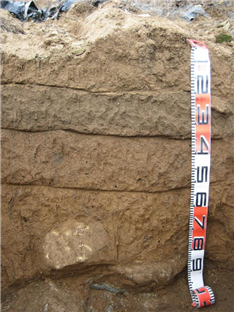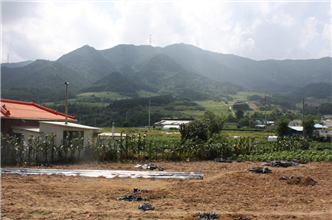

Morphological properties of typifying pedon.
|
|
GAGHWA SERIES |
Established Series UKT, KBJ, JFD 3 November, 1969 |
The Gaghwa series are members of the fine, mixed, mesic family of Typic Haplohumults [Leptic Umbric Cutanic Alisols (Alumic Humic Hyperdystric Siltic) classified by WRB]. These soils have dark brown sandy loam Ap horizons, dark grayish brown silt loam BAt horizons, brown silty clay loam Bt1 horizons, and dark yellowish brown silty clay Bt2 horizons. They are developed on mountain colluvial slopes derived from acidic crystalline or similar materials.
Typifying Pedon: Gaghwa sandy loam-corn (Colors are for moist soil).
Slope: 7-15%
Elevation: 513 m above m.s.l.
Soil moisture regime: Udic
Soil temperature regime: Mesic
Parent material: Colluvium from granite and granite-gneiss
Diagnostic features: An umbric epipedon from a depth of 0 to 19 cm and an argillic horizon from a depth of 19 to 84 cm (An umbric horizon from a depth of 0 to 19 cm and an argic horizon from a depth of 19 to 84 cm by WRB).
Described by: Song, K. C., S. J. Jung, and D. C. Noh, 17 May, 2005.
|
|
|
|
|
Morphological properties of typifying pedon. |
||
Ap - 0 to 19 cm. Dark brown (10YR 3/3) sandy loam; structureless, massive; friable, slightly sticky and slightly plastic; common fine to medium roots; common fine to medium pores; soil dressing; clear smooth boundary.
BAt - 19 to 34 cm. Dark grayish brown (10YR 4/2) silt loam; moderate granular structure; firm, sticky and plastic; few fine roots; common fine to medium pores; clear smooth boundary.
Bt1 - 34 to 54 cm. Brown (10YR 4/3) silty clay loam; moderate subangular blocky structure; firm, sticky and plastic; thin patch clay cutans; common fine roots; common fine pores; clear smooth boundary.
Bt2 - 54 to 84 cm. Dark yellowish brown (10YR 4/4) silty clay; moderate angular blocky structure; firm, very sticky and very plastic; thin continuous clay cutans; few fine roots; common fine to medium pores; few macro worm pores; about 20% bouldary stones; clear wavy boundary.
R - More than 84 cm. Granite bedrock.
The typifying pedon has an umbric epipedon from a depth of 0 to 19 cm and an argillic horizon from a depth of 19 to 84 cm. It has a base saturation (by sum of cations) of less than 35% at 125 cm below the upper boundary of the argillic horizon. That can be classified as Ultisol. It has 0.9% or more organic carbon in the upper 15 cm of the argillic horizon and keys out as Humult. Also it meets the requirements of Typic Haplohumult.
The typifying pedon has more than 35% clay at the particle-size control section and has mesic soil temperature regime. Therefore it can be classified as fine, mixed, mesic family of Typic Haplohumult.
Type Location: About 400 meters west of the Mumyeong Bridge, Sinri 4 Ri, Daehwa Myeon, Pyeongchang Gun, Gangwon Do (128o 26' 56.9", 37o 32' 14.1").
Range in Characteristics: These soils have umbric epipedons and argillic horizons. Solum thickness ranges 50 to 100 cm. Depth to hard rock is less than 100 cm. Reaction is very strongly acid. Base saturation is less than 35 percent. Ap horizons are dark brown loam to clay loam. Bt horizons are brown, dark yellowish brown, or yellowish red clay loam, silty clay loam, or silty clay.
Competing Series and Their Differentiae: These are the Jeongeub, Unbong, Ungyo, and Mangsil series. The Jeongeub soils have 10 to 35% gravels in the profiles. The Unbong and Ungyo soils have fine loamy texture class. The Mangsil soils occur at high elevations in mountainous regions with moderately weathered andesite materials and have fine loamy texture class.
Setting: The Gaghwa soils occur on sloping to moderately steep, dissected, colluvial slopes. Dominant slopes are between 7 and 15 percent and the range is from 2 to 60 percent.
Principal Associated Soils: The Anryong, Jangwon, Wonji, Chilgog, and Geumgog soils are associated. The Anryong, Jangwon, and Wonji soils are associated in similar positions. The Chilgog and Geumgog soils are associated in lower positions.
Drainage and Permeability: Well drained. Runoff is medium to rapid. Permeability is moderately slow or slow.
Use and Vegetation: Most of these soils are used for upland crops such as barley, sesame, radish and soybean. About one-third grows pine forest, scrub and wild grass.
Distribution and Extent: The Gaghwa soils occur on mountain colluvial slopes and fan terraces in granite, granite gneiss and areas of similar materials throughout the country. These soils have large extent though individual areas may be relatively small.
Series Established: Gwangju City, 1967. Revised, Pyeongchang Gun, Gangwon Do, 2005.
Laboratory data sheets of typifying pedon.
|
Depth (cm) |
Horizon |
( --- Total ---) |
(-- Clay --) |
(-- Silt --) |
(------- Sand -------) |
||||||||
|
Clay |
Silt |
Sand |
Fine |
Coarse |
Fine |
Coarse |
VF |
F |
M |
C |
VC |
||
|
LT |
.002 |
.05 |
LT |
LT |
.002 |
.02 |
.05 |
.10 |
.25 |
.5 |
1 |
||
|
.002 |
- .05 |
- 2 |
.0002 |
.002 |
- .02 |
- .05 |
- .10 |
- .25 |
- .50 |
- 1 |
- 2 |
||
|
- - - - - - - - - - - Pct of ˂ 2mm (3A1) - - - - - - - - - - - |
|||||||||||||
|
0-19 |
A |
15.1 |
26.7 |
58.2 |
|
|
18.8 |
8.0 |
6.5 |
12.6 |
12.3 |
15.4 |
10.6 |
|
19-34 |
BAt |
29.7 |
58.6 |
11.7 |
|
|
46.7 |
11.9 |
2.2 |
2.4 |
2.5 |
3.7 |
1.3 |
|
34-54 |
Bt1 |
34.7 |
58.4 |
6.9 |
|
|
46.2 |
12.2 |
0.7 |
0.4 |
1.7 |
2.1 |
1.1 |
|
54-84 |
Bt2 |
34.6 |
61.4 |
5.0 |
|
|
50.1 |
11.3 |
0.9 |
0.9 |
1.1 |
1.6 |
0.5 |
|
84- |
R |
|
|
|
|
|
|
|
|
|
|
|
|
|
Depth (cm) |
Coarse Fractions(mm) |
˃2mm |
Orgn |
Total |
Extr |
Total |
(-- Dith -Cit --) |
|||||
|
Weight |
Wt |
C |
N |
P |
S |
Extractable |
||||||
|
2-5 |
5-20 |
20-75 |
.1-75 |
Pct of |
|
|
|
|
Fe |
Al |
Mn |
|
|
|
|
|
|
Whole |
6A1c |
6B3a |
6S3 |
6R3a |
6C2b |
6G7a |
6D2a |
|
|
Pct of ˂ 75mm (3B1) |
Soil |
Pct ˂ 2mm |
g/kg |
Pct of ˂ 2mm |
||||||||
|
0-19 |
|
|
|
|
|
1.13 |
|
|
|
|
|
|
|
19-34 |
|
|
|
|
|
2.15 |
|
|
|
|
|
|
|
34-54 |
|
|
|
|
|
1.46 |
|
|
|
|
|
|
|
54-84 |
|
|
|
|
|
0.62 |
|
|
|
|
|
|
|
84- |
|
|
|
|
|
|
|
|
|
|
|
|
|
Depth (cm) |
Ratio/Clay |
Atterberg |
( Bulk Density ) |
COLE |
(- Water Content -) |
WRD |
|||||||
|
CEC |
1500 |
Limits |
Field |
33 |
Oven |
Whole |
Field |
10 |
33 |
1500 |
Whole |
||
|
|
kPa |
LL |
PI |
Moist |
kPa |
Dry |
Soil |
Moist |
kPa |
kPa |
kPa |
Soil |
|
|
8D1 |
8D1 |
4P1 |
4P |
4A3a |
4A1d |
4A1h |
4D1 |
4B4 |
4B1c |
4B1c |
4B2a |
4C1 |
|
|
|
|
Pct ˂0.4mm |
- - g/cc - - |
cm/cm |
-- Pct of ˂2mm -- |
cm/cm |
|||||||
|
0-19 |
0.74 |
|
|
|
1.34 |
|
|
|
17.5 |
|
|
|
|
|
19-34 |
0.67 |
|
|
|
1.37 |
|
|
|
28.5 |
|
|
|
|
|
34-54 |
0.49 |
|
|
|
10.9 |
|
|
|
37.1 |
|
|
|
|
|
54-84 |
0.48 |
|
|
|
1.37 |
|
|
|
30.5 |
|
|
|
|
|
84- |
|
|
|
|
|
|
|
|
|
|
|
|
|
|
Depth (cm) |
( NH4OAc Extractable Bases ) |
Acid- |
Extr |
(----- CEC -----) |
Al |
||||||
|
Ca |
Mg |
K |
Na |
Sum |
ity |
Al |
Sum |
NH4- |
Bases |
Sat |
|
|
5B5a |
5B5a |
5B5a |
5B5a |
Bases |
|
|
Cats |
OAc |
+ Al |
|
|
|
6N2e |
6O2d |
6Q2b |
6P2b |
|
6H5a |
6G9a |
5A3a |
5A8b |
5A3b |
5G1 |
|
|
- - - - - - - - - - - - meq / 100g - - - - - - - - - - - - |
Pct |
||||||||||
|
0-19 |
2.1 |
0.5 |
0.5 |
0 |
3.1 |
13.5 |
2.2 |
16.6 |
11.2 |
5.3 |
41.5 |
|
19-34 |
0.7 |
0.2 |
0. |
0 |
1.4 |
22.0 |
5.3 |
23.4 |
20.0 |
6.7 |
79.1 |
|
34-54 |
0.6 |
0.2 |
0.4 |
0 |
1.2 |
20.0 |
5.3 |
21.2 |
17.0 |
6.5 |
81.5 |
|
54-84 |
1.7 |
0.6 |
0.6 |
0 |
3.0 |
16.5 |
3.4 |
19.5 |
16.0 |
6.4 |
53.1 |
|
84- |
|
|
|
|
|
|
|
|
|
|
|
|
Depth (cm) |
(Base Sat) |
CO3 as |
Res |
Cond |
(------ pH ------) |
Acid Oxalate Extraction |
|||||||
|
Sum |
NH4- |
CaCO3 |
|
|
NaF |
KCl |
CaCl2 |
H2O |
Opt |
Al |
Fe |
Si |
|
|
|
OAc |
˂2mm |
|
|
|
|
.01M |
|
Den |
|
|
|
|
|
5C3 |
5C1 |
6E1g |
8E1 |
8I |
8C1d |
|
8C1f |
8C1f |
8J |
6G12 |
6C9a |
6V2 |
|
|
---- Pct ---- |
ohms/cm |
dS/m |
|
1: 1 |
1: 2 |
1: 1 |
|
- Pct of ˂2mm - |
|||||
|
0-19 |
18.8 |
28.0 |
|
|
|
|
3.4 |
4.1 |
4.6 |
|
|
|
|
|
19-34 |
6.0 |
7.0 |
|
|
|
|
3.4 |
3.8 |
4.4 |
|
|
|
|
|
34-54 |
5.7 |
7.1 |
|
|
|
|
3.7 |
4.2 |
4.6 |
|
|
|
|
|
54-84 |
15.4 |
18.6 |
|
|
|
|
3.7 |
4.5 |
4.9 |
|
|
|
|
|
84- |
|
|
|
|
|
|
|
|
|
|
|
|
|